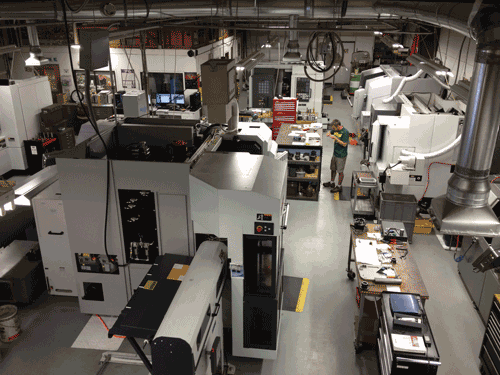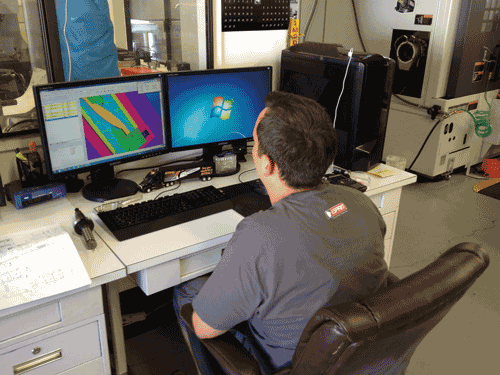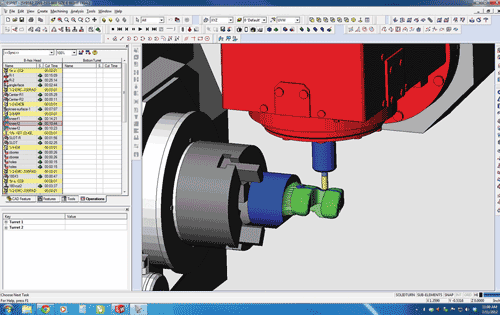Consolidating CAM Software Cuts Programming Time
At Trillium Machine Inc., there’s no room for thinking within the comfy confines of “the box,” working in the “comfort zone,” or refusing to try the untried.
At Trillium Machine Inc., there’s no room for thinking within the comfy confines of “the box,” working in the “comfort zone,” or refusing to try the untried.
This precision job shop in Sandy, Ore., has no room—let alone the luxury of time—for embracing the ordinary.
Featured Content
Because trumping the norm is the company’s specialty, it comes as no surprise that Tyler Bureau, its V.P. of manufacturing, zeroes in on the big picture of manufacturing and how Trillium can best succeed within it. Or, better yet, outside of it.
“We’ve seen a lot of companies that were similar to us in capabilities 10 years ago not make the investments that we have, and they’re stuck in the same place,” Mr. Bureau says. “Last year was our biggest year.”
Among investments made by the 27-year-old company are complex machinery and sophisticated CAM software. The company’s capabilities include milling, turning, mill/turn, five-axis and Swiss-type machining. With quality control and laser engraving services as well, about the only thing it doesn’t do is wire EDM, the company says.
About 18 months ago, following the acquisition of a Mori Seiki NT 1000 mill/turn machine tool, Mr. Bureau saw it was time to review the company’s use of CAM software. As the new machine tool’s control was equipped with Esprit CAM software by DP Technology, Esprit became one among several brands of CAM used to program the shop’s array of machine tools.
“As I started using the new machine, I realized that I had four programs to deal with in making parts on various machines,” Mr. Bureau says, who began reviewing his CAM software options at a manufacturing trade show. The goal, he explains, was to consolidate the company’s use of CAM software to one brand.
“When you work with several different types of CAM, you have to constantly shift gears and, in each case, you have to adjust to certain limitations,” he says. “You have to keep in mind there are differing capabilities between the types of software.”
A no-cost Esprit Skill Builder event attended by Mr. Bureau proved to be a deciding factor for Trillium. “We attended the workshop and saw that the software was the only software we looked at that could program every type of machine,” he says. “I also knew that Mori Seiki had decided it was the best for programming its machines, which isn’t a decision that would be made lightly.”
The ability to program every type of machine tool is a must-have for a precision job shop such as Trillium, which performs jobs that range from prototype runs of five or ten parts to large production runs.
About 50 percent of jobs performed at Trillium are for the medical industry and include parts such as implants, prosthetics and surgical instruments. Another 40 percent of jobs are for the aerospace industry, while the remaining 10 percent is prototype work for various industries, including automotive.
In his 13 years at Trillium, Mr. Bureau has learned, among other things, the necessity of diversifying capability. Though the company experienced a downturn, as did so many others following the events of Sept. 11, 2001, business has steadily increased over the past several years.
“We’ve been able to increase business by being diversified,” he says. “We don’t count on one customer to pay the bills. We don’t set ourselves up for failure.”
At Trillium, setting up for success includes being able to do what others can’t in terms of manufacturing complex parts and embracing exotic materials. Plastics and various types of titanium are par for the course. “I’m the guy who people come to when they have parts they say can’t be made,” Mr. Bureau says.
From where Mr. Bureau’s standing, turning a profit while accomplishing what others cannot requires automation. “If you want to make it in manufacturing in America today, you have to have automation,” he says. “You can’t pay a guy to run one part at a time.”
The company maximizes manpower by automating. By running three shifts—day, swing and graveyard—Trillium is open for business 6 days a week, 24 hours a day, during which at least two machines are always going, but more than likely three or four.
“The ultimate goal of our company is to keep moving forward,” Mr. Bureau says. “We want to expand, keep the automation going, have the staff we need and pay them well.”
In order to continue advancing its business and using automation to its advantage, the company has invested in the latest equipment. Trillium purchased its first Mori Seiki NL-series lathe in 2005 and has since added additional NL-series machine tools and Swiss turning machines. It also now boasts two fully automated Swiss machines, one Mori Seiki NT-series mill-turn machine and a bar loader among its lineup.
“We’re making tens of thousands of parts on those machines,” Mr. Bureau says. “In the past, we paid one guy to load those parts one at a time, and now we have an employee who checks the parts every 30 minutes to 2 hours.”
Running all of its equipment, complex or otherwise, with the same CAM software generates a faster and more efficient workflow, with fewer human errors because of completing quality parts in fewer (ideally only one) operations.
“So many people out there are fine with programmers performing extensive edits, but it adds up,” Mr. Bureau says. “You compromise your employees and your machines, and your parts are just mediocre. How are you going to be competitive? You can’t.”
With Esprit on line, Trillium has cut hand-editing time, is generating accurate CNC code the first time out and is eliminating programming limitations.
“There are lots of little things that add up and allow you to take full advantage of the machine tool,” Mr. Bureau says. “So many other types of software don’t allow you to output the actual code in certain situations. Ask some companies to show you the code for tilting the subspindle on the NT. They can’t do it. I enjoy programming more because I sometimes didn’t feel like trying to get some of the other software to do exactly what I wanted it to do.”
To make a part in Esprit, Mr. Bureau typically imports a solid model into the software and begins programming. As the software offers solids-based programming, it’s easy to edit a part within the CAM software and make adjustments on the fly.
Mr. Bureau favors the time-saving advantages of Esprit’s “Process Saving” capability, which enables programmers to save toolpath parameters. If a programmer has saved a process for roughing a titanium part based on part features as opposed to dimensions, he or she can automatically apply that process to new or slightly different parts.
In the case of a family of parts for knee implant trials, Trillium was able to apply saved processes and dramatically cut programming time. This is especially important when you have various sizes of the same part that requires writing a new program for each part. “Why re-invent the wheel?” Mr. Bureau says.
Esprit’s support is another favorite feature. “What really sets the software apart is its support,” Mr. Bureau says. “This product support is among the best of any company I have worked with.”
Between DP Technology’s software support, and the software’s ability to save programming time and apply saved processes as well as solids-based programming, Trillium’s creative thinking has achieved the manufacturing of complex parts and parts using exotic materials efficiently, which is what the shop hoped to accomplish.
RELATED CONTENT
-
Adding 5-Axis Capability to a 3-Axis CNC Mill
This attachment provides shops using thee-axis machining centers the option of on-demand four- and five-axis machining.
-
Precision Machining Eastec Technology Preview September 2021
Production Machining highlights some of the latest precision machining advances and technology updates that will be showcased at Eastec 2021, Oct. 19-21 in West Springfield, Massachusetts.
-
How to Get More Efficient Production from Swiss-Type and Multitasking Machines
SolidCAM for multi-axis Swiss type and multitasking machines provides a very efficient CAM programming process, generating optimal and safe Mill-Turn programs, with dramatically improved milling tool life.









